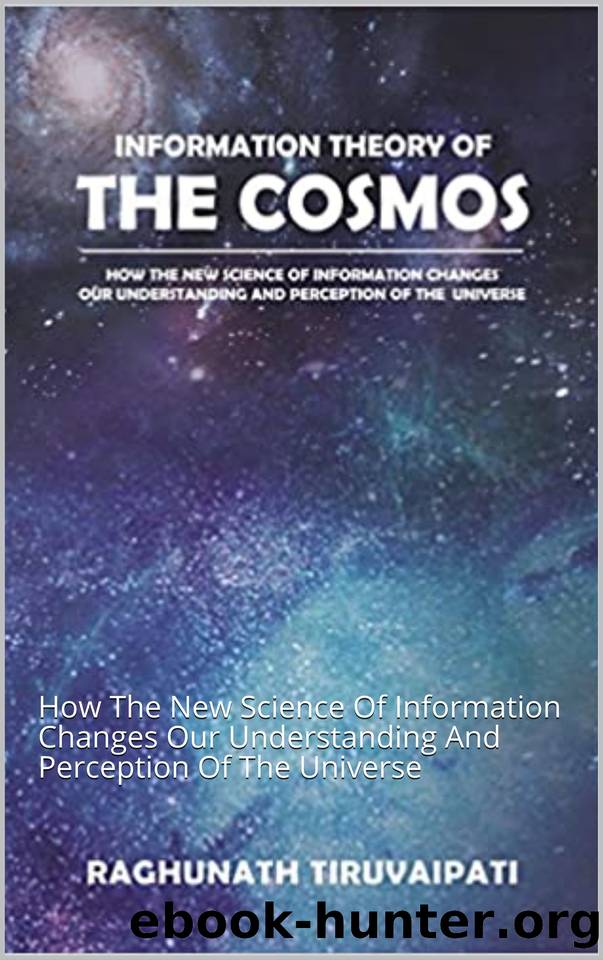Information Theory Of The Cosmos: How The New Science Of Information Changes Our Understanding And Perception Of The Universe by Tiruvaipati Raghunath

Author:Tiruvaipati, Raghunath [Tiruvaipati, Raghunath]
Language: eng
Format: epub
Publisher: UNKNOWN
Published: 2020-10-13T16:00:00+00:00
Supernova 1987A in the Large Magellanic Cloud.This picture shows the faint outer rings and bright inner ring characteristic of an hourglass nebula.
With respect to the cosmological problem of the matterantimatter asymmetry, one theoretical approach is founded on the idea of a grand unified theory (GUT), which seeks to explain the electromagnetic, weak nuclear, and strong nuclear forces as a single grand force of nature. This approach suggests that an initial collection of very heavy particles, with zero baryon and lepton number, may decay into many lighter particles (baryons and leptons) with the desired average for the net baryon number (and net lepton number) of a few parts per 109. This event is supposed to have occurred at a time when the universe was perhaps 10â35 second old.
Another approach to explaining the asymmetry relies on the process of CP violation, or violation of the combined conservation laws associated with charge conjugation (C) and parity (P) by the weak force, which is responsible for reactions such as the radioactive conjugation implies that oppositely charged antimatter counterpart, or antiparticle. Parity conservation means that left and right and up and down are indistinguishable in the sense that an atomic nucleus emits decay products up as often as down and left as often as right. With a series of debatable but plausible assumptions, it can be demonstrated that the observed imbalance or asymmetry in the matter-antimatter ratio may have been produced by the occurrence of CP violation in the first seconds after the big bang. CP violation is expected to be more prominent in the decay of particles known as B-mesons. In 2010, scientists at the Fermi National Acclerator Laboratory in Batavia, Ill., finally detected a slight preference for B-mesons to decay into muons rather than anti-muons.
decay of atomic nuclei. Charge every charged particle has an
Superunification And The Planck Era
Why should a net baryon fraction initially of zero be more appealing aesthetically than 10â9? The underlying motivation here is perhaps the most ambitious undertaking ever attempted in the history of scienceâthe attempt to explain the creation of truly everything from literally nothing. In other words, is the creation of the entire universe from a vacuum possible?
The evidence for such an event lies in another remarkable fact. It can be estimated that the total number of protons in the observable universe is an integer 80 digits long. No one of course knows all 80 digits, but for the argument about to be presented, it suffices only to know that they exist. The total number of electrons in the observable universe is also an integer 80 digits long. In all likelihood these two integers are equal, digit by digitâif not exactly, then very nearly so. This inference comes from the fact that, as far as astronomers can tell, the total electric charge in the universe is zero (otherwise electrostatic forces would overwhelm gravitational forces). Is this another coincidence, or does it represent a deeper connection? The apparent coincidence becomes trivial if the entire universe was created from a vacuum since a vacuum has by definition zero electric charge.
Download
This site does not store any files on its server. We only index and link to content provided by other sites. Please contact the content providers to delete copyright contents if any and email us, we'll remove relevant links or contents immediately.
Man-made Catastrophes and Risk Information Concealment by Dmitry Chernov & Didier Sornette(5646)
The Revenge of Geography: What the Map Tells Us About Coming Conflicts and the Battle Against Fate by Kaplan Robert D(3961)
Zero Waste Home by Bea Johnson(3653)
In a Sunburned Country by Bill Bryson(3364)
COSMOS by Carl Sagan(3346)
Good by S. Walden(3344)
The Fate of Rome: Climate, Disease, and the End of an Empire (The Princeton History of the Ancient World) by Kyle Harper(2870)
Camino Island by John Grisham(2718)
A Wilder Time by William E. Glassley(2687)
Organic Mushroom Farming and Mycoremediation by Tradd Cotter(2563)
The Ogre by Doug Scott(2501)
Human Dynamics Research in Smart and Connected Communities by Shih-Lung Shaw & Daniel Sui(2431)
Energy Myths and Realities by Vaclav Smil(2380)
The Traveler's Gift by Andy Andrews(2298)
9781803241661-PYTHON FOR ARCGIS PRO by Unknown(2268)
Inside the Middle East by Avi Melamed(2230)
Birds of New Guinea by Pratt Thane K.; Beehler Bruce M.; Anderton John C(2175)
A History of Warfare by John Keegan(2101)
Ultimate Navigation Manual by Lyle Brotherton(2048)
